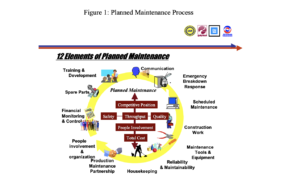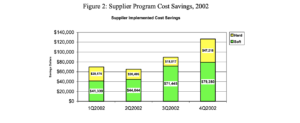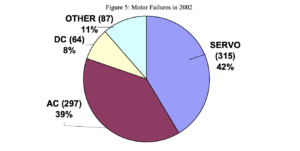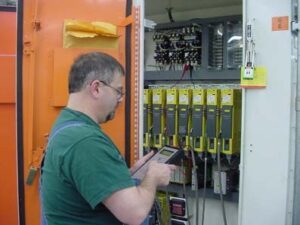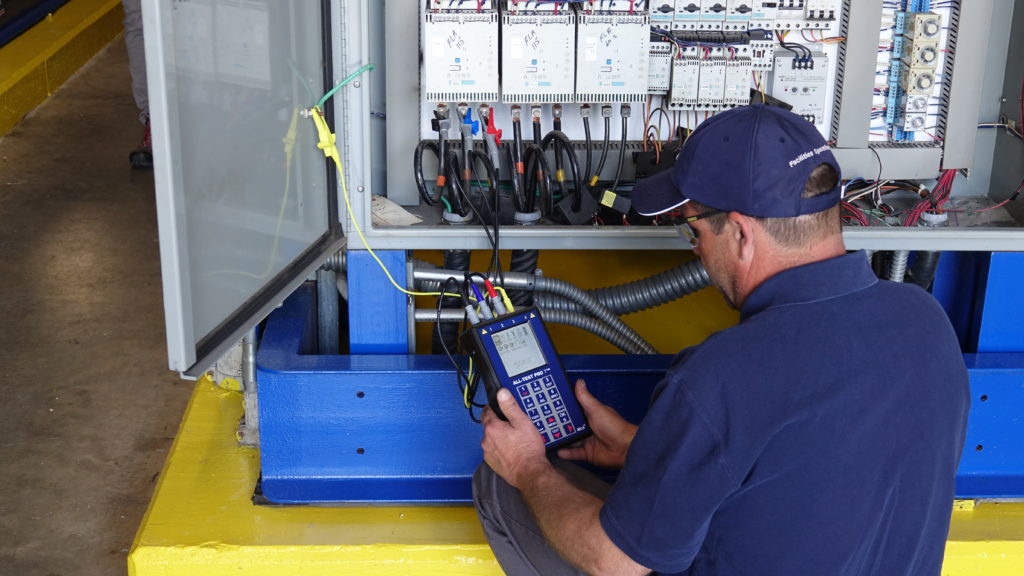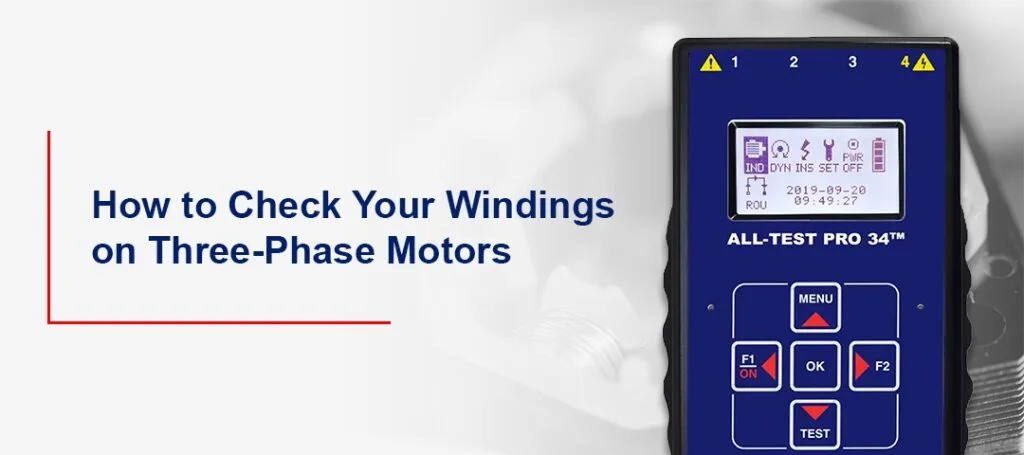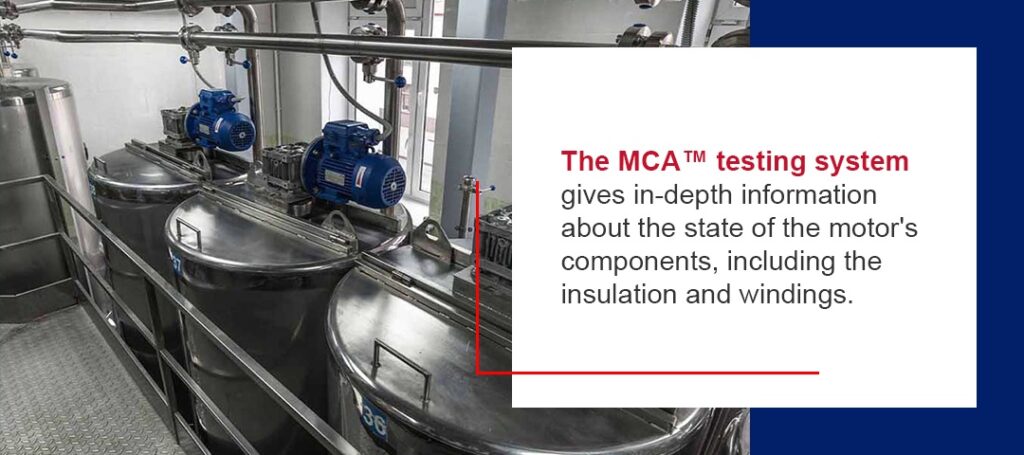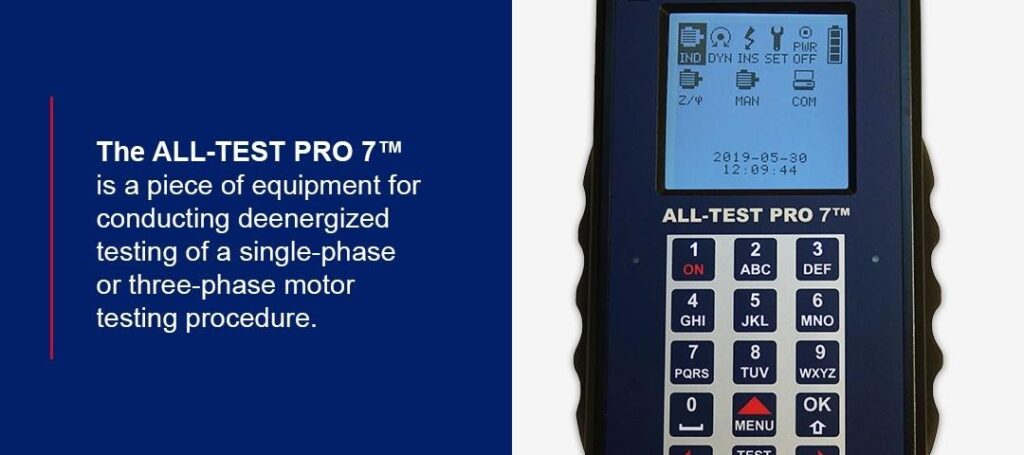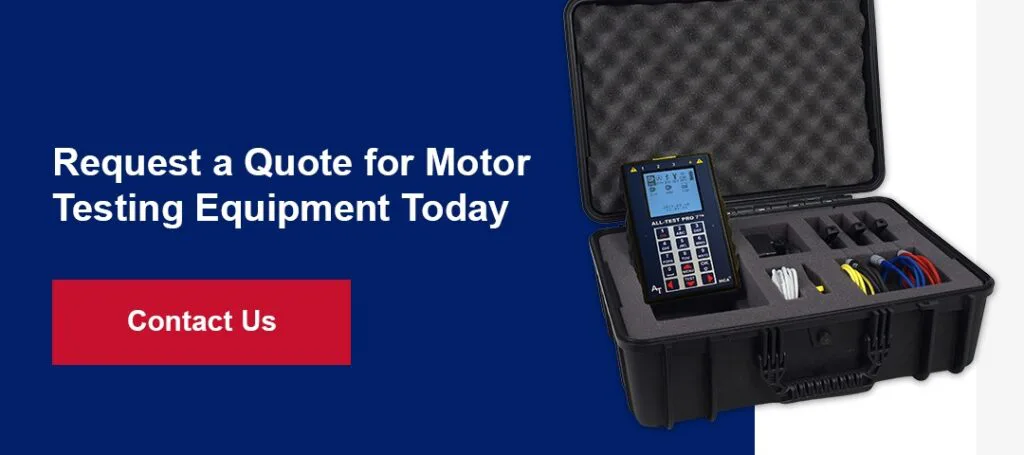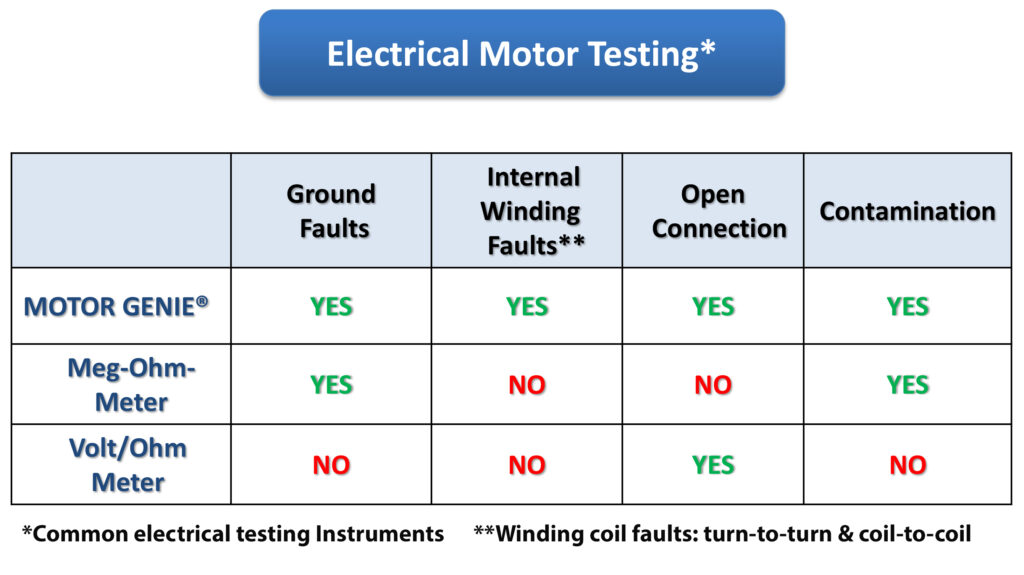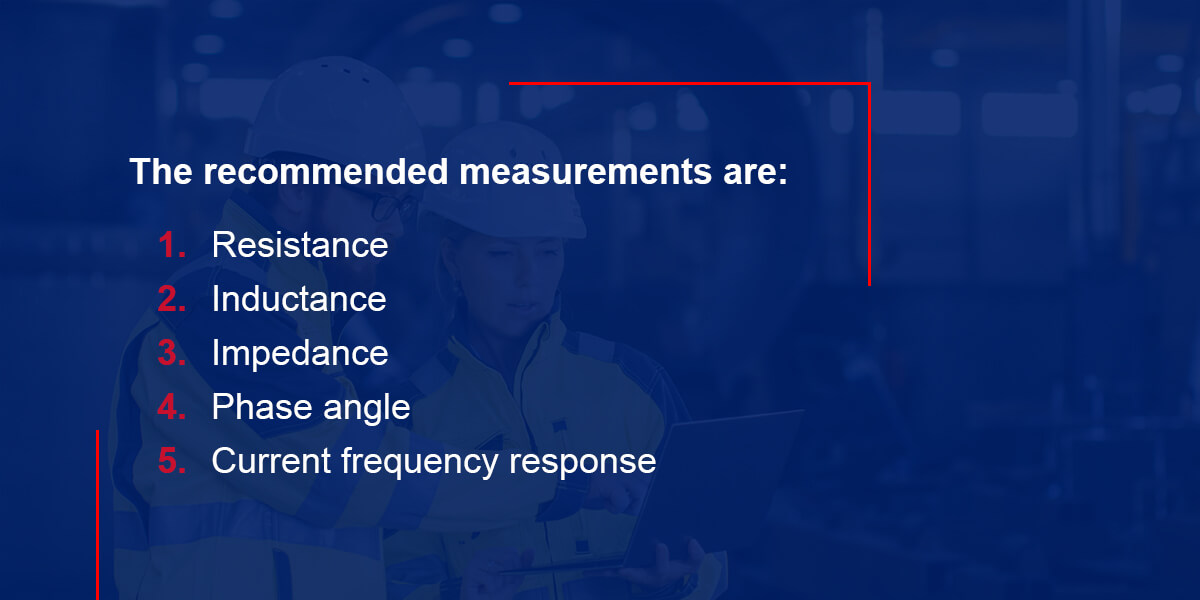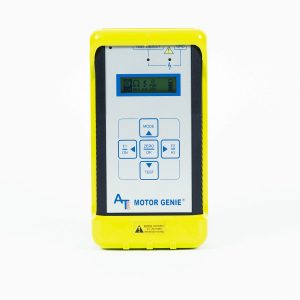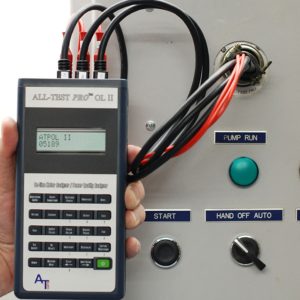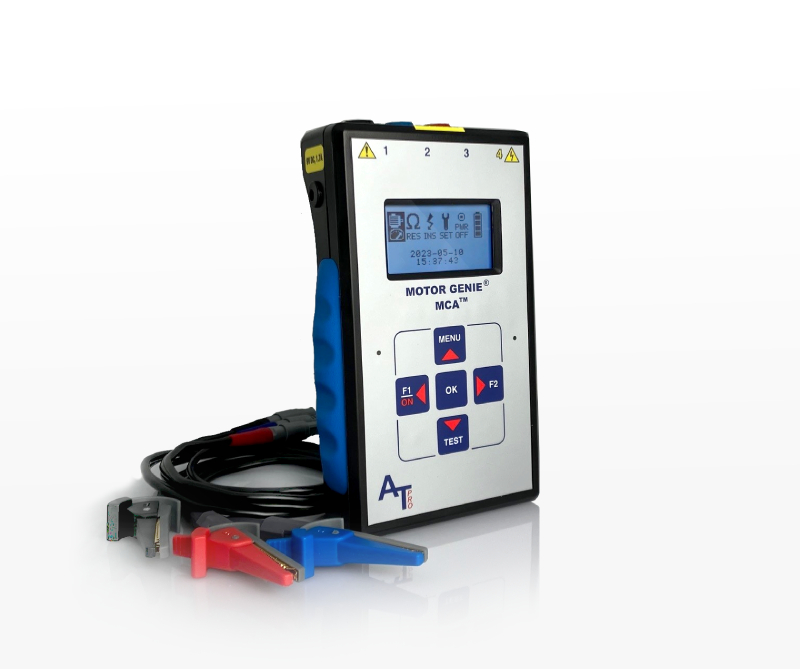Regarding electric motor testing, polarization index (PI) is a measure of how much the insulation system resistance improves (or degrades) over time.
While the PI Test has been considered the primary test when evaluating the condition of a motor’s insulation, its process has become outdated compared with newer testing methods that provide a more comprehensive diagnostic evaluation of a motor’s overall health.
This article provides a practical understanding of a motor’s insulation system, a basic understanding of polarization index testing, and how modern motor testing methods provide more comprehensive results in less time.
POLARIZATION INDEX (PI)
The polarization index (PI) test is a standard electric motor testing method developed in the 1800s that attempts to determine the health of a motor’s winding insulation.
While the PI test provides information on ground wall insulation (GWI) systems typically installed prior to the 1970s, it fails to provide an accurate condition of the winding insulation in modern motors.
PI testing involves applying DC voltage (typically 500V – 1000V) to the motor’s winding to measure the effectiveness of the GWI system to store an electrical charge.
Since the GWI system forms a natural capacitance between the motor windings and the motor frame, the applied DC voltage will be stored as an electrical charge the same as any capacitor.
As the capacitor becomes fully charged, the current will decrease until all that remains is the final leakage current, which determines the amount of resistance the insulation provides to ground.
In new, clean insulation systems, the polarization current decreases logarithmically with time as the electrons are being stored. The Polarization Index (PI) is the ratio of the insulation resistance to ground (IRG) value taken at 1 and 10-minute intervals.
PI = 10 Minute IRG/1 Minute IRG
On insulation systems installed pre-1970s, PI testing occurs while the dielectric material is being polarized.
If the ground wall insulation (GWI) begins to degrade, it undergoes a chemical change causing the dielectric material becoming more resistive and less capacitive, lowering the dielectric constant and reducing the ability of the insulation system to store an electrical charge. This causes the polarization current to become more linear as it approaches the range where leakage current is predominate.
However, on newer insulation system post 1970’s, for various reasons the entire polarization of the dielectric material occurs in less than one minute, and the IRG readings are above 5,000 Meg-ohms. The calculated PI may not be meaningful as an indication of condition of the ground wall indication.
Additionally, since this test creates the electrostatic field between the windings and the motor frame it provides very little if any indication of the condition of the winding insulation system. The best indication of these types of faults through the use of MCA measurements of phase angle and the current frequency response.
INSULATING MATERIALS
In electric motors, insulation is the material that resists the free flow of electrons, directing the current through a desired path and preventing it from escaping elsewhere.
In theory, the insulation should block all current flow, but even the best insulating material allows a small amount of current to pass through. This excess current is commonly referred to as leakage current.
While it is generally accepted that motors have a 20-year life span, failure of the insulating system is the primary reason electric motors fail prematurely.
The insulating system begins to degrade when the insulation becomes more conductive due to a change in its chemical composition. The insulation’s chemical makeup changes over time from gradual use and/or other damages. The leakage current is resistive and creates heat which results in additional and more rapid degradation of the insulation.
Note: Most enameled wires are engineered to guarantee a service life of 20,000 hours at rated temperatures (105 to 240° C).
INSULATION SYSTEMS
Motors and other electrical equipment with coils have 2 separate and independent insulating systems.
Ground wall insulation systems separate the coil from the frame of the motor, preventing voltage supplied to the windings from escaping to the stator core or any part of the motor frame. Breakdown of the ground wall insulation system is called a ground fault and creates a safety hazard.
Winding insulation systems are layers of enamel that surround the conducting wire that provides current to the entire coil to create the stator magnetic field. Breakdown of the winding insulation system is called a winding short and weakens the coil’s magnetic field.
INSULATION RESISTANCE TO GROUND (IRG)
The most common electrical test conducted on motors is the insulation resistance to ground (IRG) test or “spot test”.
By applying DC voltage to the motor winding, this test determines the point of minimum resistance the ground wall insulation presents to the motor frame.
CAPACITANCE
Capacitance (C), measured in Farads, is defined as the ability of a system to store an electrical charge. Establishing the capacitance of a motor is found by using the equation: 1 Farad = the amount of stored charge in coulombs (Q) divided by the supply voltage.
Example: If applied voltage is a 12V battery and the capacitor stores .04 coulombs of charge it would have a capacitance of .0033 Farads or 3.33 mF. One coulombs of charge is approximately 6.24 x 1018 electrons or protons. A 3.33 mF capacitor would store approximately 2.08 X 1016 electrons when fully charged.
Capacitance is created by placing a dielectric material between conductive plates. In motors, ground wall insulation systems form a natural capacitance between the motor windings and motor frame. The winding conductors form one plate and the motor frame forms the other, making the ground wall insulation the dielectric material.
The amount of capacitance depends on:
The measured surface area of the plates – Capacitance is directly proportional to the area of the plates.
The distance between the plates – Capacitance is inversely proportional to distance between the plates.
The dielectric constant – Capacitance is directly proportional to the dielectric constant
CAPACITANCE TO GROUND (CTG)
The capacitance-to-ground (CTG) measurement is indicative of the cleanliness of the windings and cables of a motor.
Because the ground wall insulation (GWI) and the winding insulation systems form a natural capacitance to ground, each motor will have a unique CTG when the motor is new and clean.
If the motor windings or GWI become contaminated, or the motor has moisture ingression, the CTG will increase. However, if either GWI or the winding insulation undergoes thermal degradation, the insulation will become more resistance and less capacitive causing the CTG to decrease.
DIELECTRIC MATERIAL
A dielectric material is a poor conductor of electricity but supports an electrostatic field. In an electrostatic field, electrons do not permeate the dielectric material and positive and negative molecules pair to form dipoles (pairs of oppositely charged molecules separated by distance) and polarize (the positive side of the dipole will align towards the negative potential and the negative charge will align towards the negative potential).
DIELECTRIC CONSTANT (K)
A dielectric constant (K) is a measure of a dielectric material’s ability to store an electrical charge by forming dipoles, relative to a vacuum which has a K of 1.
The dielectric constant of insulating material is dependent on the chemical makeup of the molecules combined to form the material.
The K of a dielectric material is affected by the material’s density, temperature, moisture content, and the frequency of the electrostatic field.
DIELECTRIC LOSS
An important property of dielectric materials is the ability to support an electrostatic field, while dissipating minimal energy in the form of heat, known as dielectric loss.
DIELECTRIC BREAKDOWN
When voltage across a dielectric material becomes too high causing the electrostatic field to become too intense, the dielectric material will conduct electricity and is referred to as dielectric breakdown. In solid dielectric materials, this breakdown may be permanent.
When dielectric breakdown occurs, the dielectric material undergoes a change in its chemical composition and results in a change in the dielectric constant.
CURRENTS EMPLOYED WITH A CHARGING CAPACITOR
Several decades ago, the polarization index test (PI) was introduced to evaluate the ability of the insulation system to store an electrical charge. Since there are essentially three different currents, as described above, involved in charging a capacitor.
Charging Current – The current accumulated on the plates and depends on the area of the plates and the distance between them. The charging current usually ends in < than 1 minute. The amount of charging will be the same regardless of the condition of the insulating material.
Polarization Current – The current required to polarize the dielectric material, or align the diploes created by placing the dielectric material in an electrostatic field. Typically with the insulation systems installed in motors (pre-1970s) when the polarization index testing was developed the nominal value of a new, clean insulation system would be in the 100’s of megaohm (106) range and would typically require more than 30 minutes and in some cases many hours to complete. However, with a newer insulation system (post-1970s) the nominal value of a new, clean insulation system will be in the giga-ohm to tera-ohm (109, 1012) and typically fully polarizes before the charging current fully finishes.
Leakage Current – The current that flows across the insulating material and dissipates heat.
CHARGING CURRENT
An uncharged capacitor has plates that share an equal number of positive and negative charges.
Applying a DC source to the plates of an uncharged capacitor will cause electrons to flow from the negative side of the battery and accumulate on the plate connected to the negative post of the battery.
This will create an excess of electrons on this plate.
Electrons will flow from the plate connected to the positive post of the battery and flow into the battery to replace the electrons accumulating on the negative plate. Current will continue to flow until the voltage on the positive plate is the same as the positive side of the battery and the voltage at the negative plate will achieve the potential of the negative side of the battery.
The number of electrons displaced from the battery to the plates depends on the area of the plates and the distance between them.
This current is referred to as the charging current, which does not consume energy and is stored in the capacitor. These stored electrons create an electrostatic field between the plates.
POLARIZING CURRENT
Placing a dielectric material between the plates in a capacitor increases the capacitance of a capacitor relative to the spacing between of plates in a vacuum.
When a dielectric material is placed in an electrostatic field, the newly formed dipoles will polarize, and the negative end of the dipole will align with the positive plate and the positive end of the dipole will align towards the negative plate. This is referred to as polarization.
The higher the dielectric constant of a dielectric material, the greater number of electrons are required, thereby increasing the capacitance of the circuit.
LEAKAGE CURRENT
The small amount of current that flows across the dielectric material while still maintaining its insulating properties is referred to as the effective resistance. This is different than the dielectric strength which is defined as the maximum voltage that a material can withstand without failing.
As an insulating material degrades, it becomes more resistive and less capacitive, increasing leakage current and decreasing the dielectric constant. The leakage current produces heat and is considered a dielectric loss.
DISSIPATION FACTOR
Is an alternative test technique that uses an AC signal to exercise groundwall insulation (GWI) system. As explained above using a DC signal to test the GWI 3 different currents are encountered, however, the instrument is unable to differentiate the currents other than the time. However, by applying an AC signal to test the GWI it is possible to separate the currents that are stored (charging current, polarization current) from the resistive current (leakage current).
Since both the charging and polarization currents are stored currents and are returned to the on the opposing ½ cycle the current leads the voltage by 90°, whereas the leakage current which is a resistive current that dissipates heat and the current is in-phase with the applied voltage. The dissipation factor (DF) is simply the ratio of the capacitive current (IC) to the resistive current (IR).
DF = IC / IR
On clean, new insulation typically the IR is < 5% of the IC, if the insulating material becomes contaminated or degrades thermally either the IC decreases or the IR increases. In either case the DF will increase.
MOTOR CIRCUIT ANALYSIS (MCA™)
Motor Circuit Analysis (MCA™), also referred to as motor circuit evaluation (MCE), is a deenergized, non-destructive test method used to assess the health of a motor. Initiated from the Motor Control Center (MCC) or directly at the motor itself, this process evaluates the entire electrical portion of the motor system, including the connections and cables between the test point and motor.
While the motor is off and unpowered, tools such as the AT7 and AT34 by ALL-TEST Pro, use MCA to assess:
- Ground Faults
- Internal Winding Faults
- Open Connections
- Rotor Faults
- Contamination
Motor testing using MCA™ tools is very easy to implement, and the test takes less than three minutes, compared to polarization index testing typically taking over 10 minutes to complete.
HOW DOES IT MOTOR CIRCUIT ANALYSIS WORK?
The electrical portion of the three phase motor system is made up of resistive, capacitive and inductive circuits. When a low voltage is applied, healthy circuits should respond in a specific way.
ALL-TEST Pro Motor Circuit Analysis tools apply a series of low-voltage, non-destructive, sinusoidal AC signals through the motor to measure the response of these signals. This deenergized test takes only a few minutes and can even be performed by an entry-level technician.
MCA measures:
- Resistance
- Impedance
- Inductance
- Fi (phase angle)
- Dissipation Factor
- Insulation to Ground
- I/F (current frequency response)
- Test Value Static (TVS)
- Dynamic Stator and Rotor Signatures
And applicable on:
- AC/DC Motors
- AC/DC Traction Motors
- Generators/Alternators
- Machine Tool Motors
- Servo Motors
- Control Transformers
- Transmission & Distribution Transformers
SUMMARY
During the 1800s, the polarization index test was an effective method of determining a motor’s overall condition. It has become less effective, however, with modern insulation systems.
While the PI test is time-consuming (15+ minutes) and unable to determine if the fault is in the winding or groundwall insulation, modern technologies, such as MOTOR CIRCUIT ANALYSIS (MCATM), identify connection issues, turn-to-turn, coil-to-coil, and phase-to-phase developing winding faults in very early stages with tests completed in under 3 minutes.
Other technologies, such as DF, CTG & IRG, provide a condition of the groundwall insulation system in tests completed in minimal time as well.
By combining new technologies, such as MCA, DF, CTG, and IRG, modern electric motor testing methods provide a much more comprehensive and thorough evaluation of an entire motor’s insulation system quicker and easier than ever before.
READ MORE

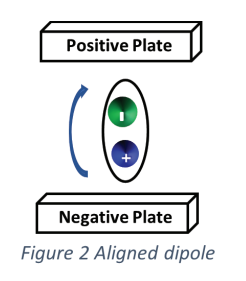

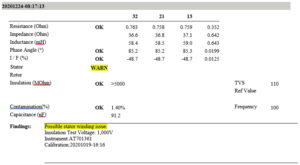
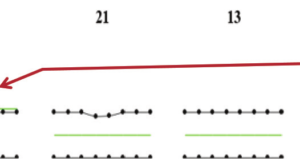

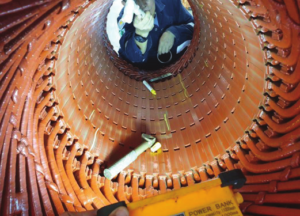
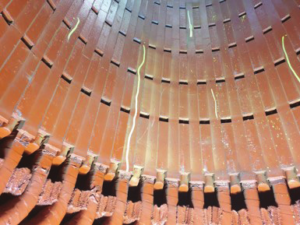



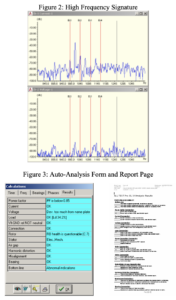 ALL-TEST PRO™ MD Kit
ALL-TEST PRO™ MD Kit